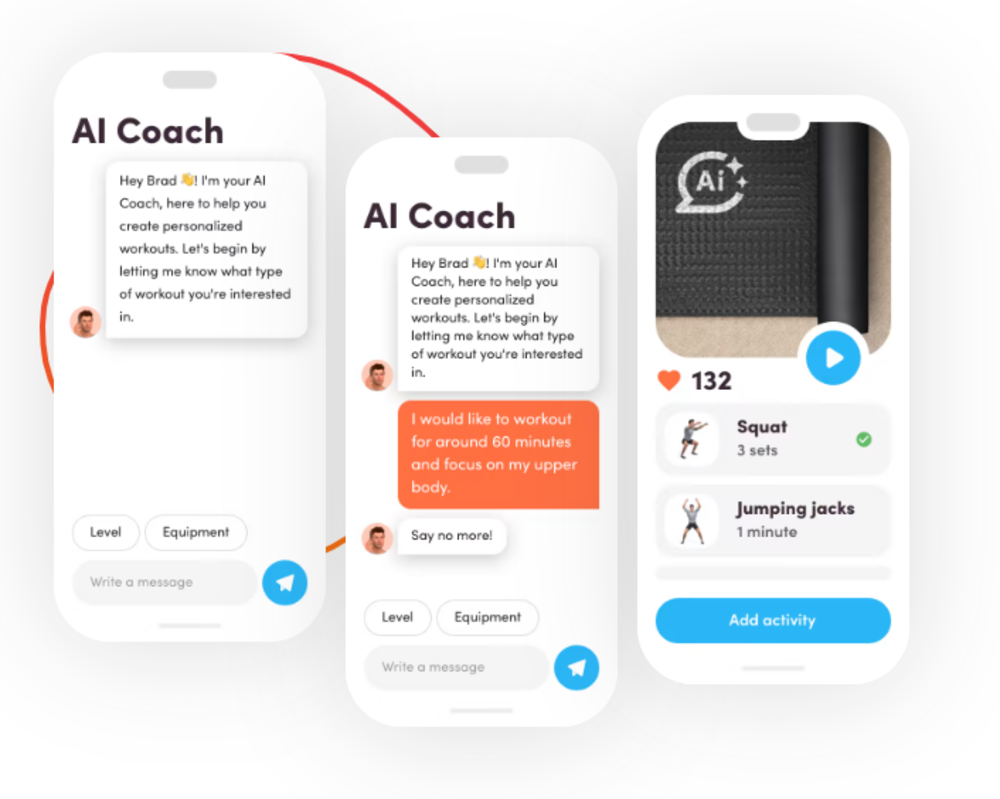Chances are, if you’re considering this niche, you’re attracted to it because there is no income ceiling. Online personal training works while you sleep, doesn’t care how many hours there are in a day, and doesn’t put you in a box that forces you to focus on time as an income-limiting factor.
Simply put, online personal training as a business model is scalable.
And in 2026, with AI, short-form video, and remote-friendly platforms dominating the wellness industry, there’s never been a better time to pivot into online coaching. But to do that effectively, it’s important to understand how online coaching differs from traditional in-person personal training and how to set up a hybrid model that leverages both.
In person coaching vs. online personal training

The key difference between a physical and online fitness coach is the delivery method. In-person coaching is time-bound and location-dependent. You trade hours for dollars, and you’re physically present during the session.
With online training, your services can be automated, pre-recorded, and delivered globally. It allows you to serve more clients without burning out.
Online training doesn’t mean less personal touch—it just means smarter systems. In fact, many online coaches offer greater accountability and support through messaging apps, check-ins, and progress tracking.
A hybrid model combines the best of both: in-person touchpoints with the scalability of digital.
If you’re already an in-person trainer, a hybrid model can help you expand without abandoning your current clients.
How to create an online personal training business
1. Decide who is your ideal client

Before you launch any part of your online personal training business, the first and most crucial step is identifying exactly who you want to serve. This clarity sets the tone for your messaging, branding, marketing strategies, and even the kind of online services you’ll offer.
Whether you’re a certified personal trainer transitioning from in-person training or starting fresh in the online fitness space, understanding your niche is everything.
You can’t market effectively to “everyone.”
A diluted message gets lost in the noise. But when you speak directly to a specific type of person—say, busy professionals who travel often or postpartum moms who want to regain strength—your message lands. That’s when your content starts attracting online personal training clients who are aligned with your mission.
How to define your niche:
Start by creating a detailed client avatar. Include:
- Demographics: Age, gender, occupation, location
- Lifestyle: Work schedule, family dynamics, fitness habits
- Pain Points: Time constraints, lack of motivation, limited access to gyms
- Goals: Fat loss, muscle building, improved mobility, mental wellness
- Training Preferences: Strength, HIIT, yoga, bodyweight, etc.
Example: If your ideal client is a 35-year-old corporate professional who wants to squeeze in effective 30-minute sessions between Zoom meetings, your online training programs should reflect that—focused, time-efficient, and mobile-friendly.
2. Define what makes you unique

In a booming fitness industry filled with personal trainers and influencers, the key to standing out is tapping into your uniqueness.
Your personal story, values, coaching style, and life experiences are your brand’s superpower. That’s what makes people choose you over someone else offering similar online personal training services.
Stand out by owning your story:
- Share your transformation or a health challenge you’ve overcome.
- Highlight any personal trainer certifications or niche specializations.
- Reflect on your coaching vibe: Are you a drill sergeant or more of a supportive guide?
- Think about client feedback—what are you consistently praised for?
This is what Dag Een did, a fitness studio that stood out by owning their story and building a unique brand around it—discover how they did it in their Virtuagym success story.
Example: “I help burned-out entrepreneurs regain their energy and confidence through minimalist strength training and mindset coaching, because I’ve been in their shoes.”
3. Experiment with existing clients

If you’re currently offering in person training, your first step toward becoming a successful online personal trainer is to test your systems with your current client base.
It’s the perfect sandbox to try different online training formats while getting valuable feedback.
You’ll quickly discover what works, what doesn’t, and how to refine your workflow. You don’t have to build a full-blown personal training business online overnight. Start simple.
Ways to experiment:
- Offer your existing clients free or discounted online training in exchange for feedback.
- Swap in-person sessions for Zoom or video calls.
- Deliver workouts as PDFs or through beginner-friendly online personal training software.
- Use WhatsApp or Telegram for daily accountability check-ins and motivational support.
Example: A client who travels a lot gets a 4-week bodyweight program, plus weekly Zoom check-ins. Their insights help you perfect the structure and delivery of your online fitness coaching system.
4. Decide on the coaching model

There’s no one-size-fits-all approach to online fitness coaching. Choosing the right coaching model is key to structuring your online personal training business effectively.
Each model offers different benefits depending on your goals, available time, and ideal client base:
Main coaching models:
- 1-on-1 Coaching. This is the most personalized approach, where you work directly with a client to create custom training programs, offer real-time feedback, and provide accountability.
- Best for: Coaches who want deep client relationships and can commit more time per client.
- Pros: Higher pricing, better retention, highly personalized experience.
- Cons: Time-intensive and harder to scale. Deep personalization, higher pricing, more time-intensive.
- Group Coaching. You coach multiple clients at once, often following a shared training program, like a challenge or bootcamp. Sessions can be live or pre-recorded.
- Best for: Coaches who want to build community and scale faster.
- Pros: More scalable, promotes motivation through group dynamics, great for challenges.
- Cons: Less personalization, requires solid group management and communication.
- Self-Paced Programs. These are fully pre-recorded, automated programs that clients follow on their own schedule, with little to no direct interaction.
- Best for: Coaches looking to generate passive income and serve a wider audience.
- Pros: Low maintenance, sell while you sleep, high scalability.
- Cons: Limited client interaction and support, lower retention without added value.
- Hybrid Coaching. A combination of live coaching (via Zoom or other platforms) and asynchronous tools (like training plans or check-ins via an app).
- Best for: Coaches transitioning from in-person training to online fitness coaching, or those wanting to balance personalization with scalability.
- Pros: Flexible, efficient, maintains a human connection while leveraging online tools.
- Cons: Still requires time and structure, but easier to manage than full 1-on-1.
Example: Start with a 30-day challenge that includes live workouts and pre-recorded sessions. Later, upsell to 1-on-1 coaching for those seeking more support.
Pro tip: Start with one model that suits your lifestyle and audience, then expand as your online personal training business grows.
5. Create workout templates

Templates are the core of a scalable online personal training business. Building custom workouts for every client from scratch isn’t sustainable. Instead, use adaptable templates as your base, and layer on personalized tweaks where needed.
In the fast-paced world of online personal training, efficiency is key. To scale your business, you need tools that save you time while still delivering high-quality, personalized programs. This is where digital tools come in handy.
Instead of building workout plans from scratch for each client, you can use a Workout Plan Creator to quickly build and customize workout templates.
By using pre-built templates, you can save hours while offering a variety of options based on goals such as weight loss, strength, hypertrophy, or mobility.
The beauty of this system is that you can adapt each plan with personal tweaks to suit the individual needs of your clients, such as adjusting for injuries, fitness levels, or preferences.
Why it matters:
Having a system that can automate part of the process means you don’t need to start from zero each time, which allows you to serve more clients without compromising quality.
By organizing templates according to goals and difficulty levels, you can also offer a variety of programs for beginners, intermediates, and advanced clients.
Pro Tips:
- Organize templates by goal (e.g., weight loss, hypertrophy, mobility)
- Use coaching software that includes a workout builder feature
- Offer beginner, intermediate, and advanced levels
- Save programs as reusable PDFs or assign them through an app
Example:
With Virtuagym, you can use the Workout Plan Creator to quickly build a strength training program tailored to your client’s goals, tweak it for their specific needs (like modifying for a past injury), and deliver it via the app. Not only does this save you time, but it also ensures your clients get a program suited to their needs—all while reducing manual work.
Pro Tip: If you’re new to coaching software, Virtuagym has just launched itsAI Coach, a tool designed to generate custom plans. With AI Coach, you can further streamline your process, creating plans faster and more efficiently.

If you prefer handling everything manually, you can still use traditional methods, but leveraging a platform like Virtuagym can significantly enhance your workflow and scalability.
6. Set up an exercise library

To deliver a premium online fitness experience, you need to help your clients demonstrate exercises safely and confidently. A clear, easy-to-access exercise library can dramatically improve results and reduce the risk of injury.
You can create your own content, but many online personal trainer platforms already offer ready-to-use video libraries. If you don’t know where to start, you can have a look at Virtuagym video exercises library. This database includes 2500+ exercises of 72+ different categories of high-quality video demos, saving you the time and effort of recording your own.
Tips for creating or using a library:
- Film with a clean background, good lighting, and clear audio
- Explain form cues in simple language
- Use horizontal video and label exercises properly
- Or use a platform that lets you integrate their library into your client-facing tools
Example: You upload your workouts using Virtuagym and link every exercise to their built-in demo videos so your clients can train confidently on their own.
7. Sign up for a coaching platform

Managing your online personal training clients through email and spreadsheets won’t cut it for long. A good personal training software keeps everything—workouts, messages, progress, and payments—in one place.
There are many platforms out there, but Virtuagym stands out for its all-in-one capabilities. Whether you’re just starting out or running a full-blown online personal training business, Virtuagym offers robust tools for both solo fitness professionals and larger teams.
Look for these features:
- Custom mobile app for clients. A custom app provides clients with easy access to their workout plans, schedules, and progress tracking. This leads to higher engagement, satisfaction, and retention. You can create a branded experience that strengthens your business presence and credibility.
- Smart workout builder with templates and video demos. This feature allows you to create personalized, dynamic workout plans quickly. With video demos and templates, you ensure clients perform exercises correctly, which reduces the time spent on creating individual plans and minimizes errors.
- Nutrition tracking and wearable sync. Offering clients integrated nutrition tracking and the ability to sync their wearable devices creates a more holistic service. This enhances client progress tracking and allows you to adjust programs based on real-time data, improving results and client satisfaction.
- Payment processing and subscription management. Automating payment processing and subscription management reduces administrative work. It ensures timely payments, simplifies billing, and helps you scale your coaching business without manually tracking transactions or chasing payments.
- Integrated chat and accountability tools. With direct communication channels built into the platform, you can easily check in with clients, answer questions, and keep them motivated. This increases client retention by providing a higher level of customer support and accountability
Example: With a coaching platform like Virtuagym, you automate payments, send workouts, and track progress all in one place. Clients access everything via a custom app, boosting engagement and efficiency.
Without a platform, you manually manage payments, workouts, and progress on separate tools, which is time-consuming and less efficient. A platform streamlines these tasks, allowing you to focus on coaching and growth.
If you’re still not sure where to start, we recommend these reads:
- Best Personal Trainer App Reviewed by Trainers & Coaches (2026)
- A Comparison of the 8 Best Personal Trainer Software
8. Create an online coaching application form
An application form filters out unqualified leads and positions you as a high-value online fitness coach. It helps you pre-qualify potential clients and learn more about them before hopping on a sales call.
Key components to include:
- Full name and email
- Current fitness level and goals
- Struggles or pain points
- Preferred coaching format (1-on-1, group, self-paced)
- Budget and timeline
Make it more engaging by including a short welcome video that explains what you offer and what they can expect as part of your online coaching experience.
Example: You embed a Typeform on your website with a video introduction, asking key questions about fitness goals, mindset, and scheduling preferences. This allows you to jump into discovery calls with clarity and confidence.
Choosing the Right Coaching Software to Launch Your Online Fitness Business
Now that you’ve mapped out the steps to transition into online coaching and defined your business model, it’s time to put the right tools in place to streamline your processes and maximize your efficiency.
The right coaching software is crucial to scale your online fitness business effectively. It saves you time, enhances client satisfaction, and supports you in delivering a high-quality experience, all while reducing your administrative workload. Without a solid platform, managing clients, workouts, payments, and progress can become overwhelming.
Here’s what to look for in the best coaching software for online trainers
1. Custom Client App
A personalized mobile app is essential for keeping your clients engaged and accountable. With a custom app, your clients can easily access their workout plans, track progress, and communicate with you on the go.
2. Smart Workout Builder with Templates and Video Demos
Save time by using an intuitive workout builder. You can create personalized workout plans quickly and even use templates for common goals like fat loss or strength training. Video demos ensure your clients perform exercises with proper form, boosting results and reducing errors.
3. Nutrition Tracking & Wearable Integration
Integrating nutrition tracking and syncing with wearable devices gives your clients a more holistic coaching experience. It allows you to adjust training programs based on real-time data, enhancing progress tracking and results.
4. Automated Payments & Subscription Management
Manage payments and client subscriptions automatically. This feature reduces manual work and ensures you’re paid on time, allowing you to focus more on coaching and less on administrative tasks.
5. Integrated Communication & Accountability Tools
Built-in chat and accountability features enable you to stay connected with clients, check in on their progress, and keep them motivated, improving retention and satisfaction.
Ready to Take Your Coaching Business to the Next Level?
It’s time to stop juggling spreadsheets and email threads—use a platform that simplifies your workflow, improves client engagement, and helps you scale your business.
Try Virtuagym’s All-in-One Coaching Platform Today!
With tools like a custom app, workout builder, nutrition tracking, and client communication all in one place, Virtuagym is designed to give you everything you need to grow your online coaching business efficiently.
Why Virtuagym?
Virtuagym is more than just a fitness platform. It’s a comprehensive solution that makes online coaching easier, more efficient, and scalable. Whether you’re just getting started or ready to take your business to the next level, Virtuagym helps you streamline your workflow and deliver exceptional service to your clients.
Ready to save time, reduce manual work, and grow your business? Get started now with a free trial of Virtuagym and see how it can transform your online coaching experience.
Next Steps
- Sign up for a Free Trial
Test out Virtuagym’s full suite of tools to see how easy it is to manage your clients and workouts all in one place. - Download the Virtuagym App
Start using the client-facing app to provide a seamless coaching experience on the go. - Build Your Online Fitness Business
With Virtuagym’s robust features, scale your business and offer personalized training at any time, anywhere.




